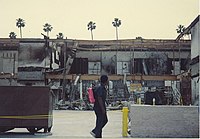
Photo from wikipedia
ABSTRACT This paper investigates journalistic discourses on “deepfakes” as the future of fake news. We analyze journalistic discourses on deepfakes over an 18-month period from 1 January 2018, when a… Click to show full abstract
ABSTRACT This paper investigates journalistic discourses on “deepfakes” as the future of fake news. We analyze journalistic discourses on deepfakes over an 18-month period from 1 January 2018, when a GoogleTrends search demonstrates that the term first began to circulate, to 1 July 2019, shortly after an altered video of Nancy Pelosi, the US Speaker of the House, circulated on social media. Based on a comprehensive thematic analysis of English-language news stories on the topic, drawn from Nexis UK, we suggest that journalistic responses to deepfakes reveal deeper anxieties both about the future of the information environment and journalism’s role within this environment. Concerns that the audiovisual nature of deepfakes makes them inherently more believable than previous fake news forms leads to worries over the impending weaponization of deepfakes by resource-rich “bad actors.” At stake is the trustworthiness of media content, and journalists’ role in providing verified content to the public. We argue that journalists conjure up speculative worst-case scenarios around deepfakes—what we refer to as “conjectured specifity” to highlight the vital importance of journalism as a bulwark against fabrication and a defender of truth.
Journal Title: Journalism Practice
Year Published: 2021
Link to full text (if available)
Share on Social Media: Sign Up to like & get
recommendations!